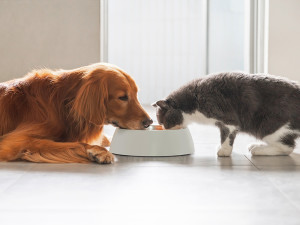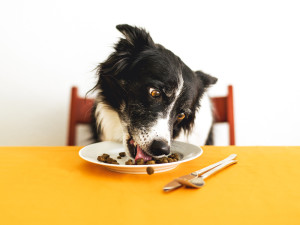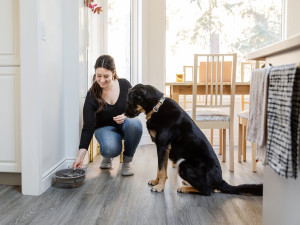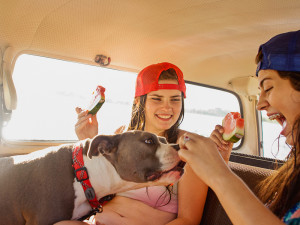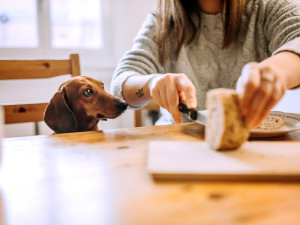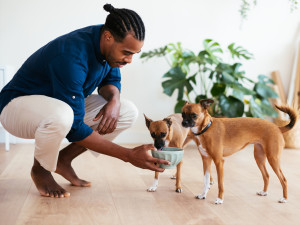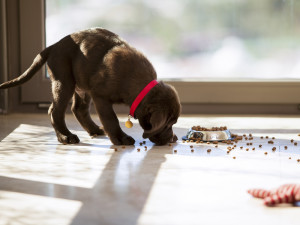How Many Calories To Feed Your Dog — And A Dog Calorie Counter
How many calories does a dog need?

share article

Your pet wants you to read our newsletter. (Then give them a treat.)
There are so many things to be worried about as a pet parent — how much you feed your dog shouldn’t be one of them. If you are concerned about your pet’s weight, the first thing you should do is determine how many calories (kcals) your dog requires. Understanding your dog’s daily caloric intake is important to keep your pup at a healthy weightopens in a new tab, so you don’t over (or under) feed your pup. Whether you make all your dog’s meals from scratch or simply add home-cooked meals as a supplement to commercial dog food — keeping your pup healthy is what’s most important. Here is everything you need to know to calculate how many calories your dog needs.
How many calories should my dog eat?
First, in order to calculate your dog’s calorie needs, you’ll need to know how many calories they use. Daily Energy Requirement (DER) is a formula widely used by veterinarians to calculate how many calories a dog requires on a daily basis. The total calorie requirement determined by DER should be divided by the number of meals (usually 2) fed to your dog daily. All treats should be accounted for, and those calories need to be subtracted from the total provided in their meals.
When it comes to canine nutrition, one calorie equals one kilocalorie (kcal), so you may see the two terms used interchangeably on food labels. Keep in mind that there are a number of different approaches that are used to calculate a dog’s caloric needs (the focus in this article is on DER), and each formula may provide slightly different results. Another popular calorie measurement used by veterinarians is Maintenance Energy Requirement. Before making any changes to your dog’s current diet, it is always recommended that you discuss this plan with your veterinarian.
Figuring out your dog’s calorie needs.
Don’t freak out, but you’ll need to do the math to determine your dog’s Daily Energy Requirements. Here’s the deceptively simple formula: =70*(kg Bodyweight) ^0.75. This formula might look a bit scary, but it’s actually easy to understand. So, bust out your math skills (or just grab a calculator), and let’s break this down into digestible information.
First, take your dog’s body weight. Let’s say your dog weighs 45 lbs. To convert this weight to a kilogram measurement, you need to divide 45 by 2.2, which results in 20.45 kg. Do that with your dog’s weight. That wasn’t too difficult, right?
Next, take your dog’s weight in kilograms to the “power” of .75. That’s the “exponent” (math lingo as represented by the ^ symbol in the formula) of your dog’s weight. On your calculator, it looks like an xʸ symbol. So, in this example, it’s 20.45^0.75. The result in this example: 9.616. That was the most challenging part of the formula, I swear. (Google can also give you this answeropens in a new tab). Multiply that number by 70, and you’ve got what’s called the Resting Energy Requirement (RER). In this example, that’s 673 kcal.
Tracking your dog’s Daily Energy Requirement.
To find out the DER, you’ll adjust your dog’s Resting Energy Requirement based on multipliers depending on your dog’s age and activity level. So, let’s say your dog is a senior – you’d multiply 673 by 1.1 – resulting in 740 calories which you’ll divide between their meals and treats. Here’s a breakdown of some other multipliers:
Moderate Active, Spay/Neutered Dog (1.6x)
Moderate Active, Intact Dog (1.8x)
Senior or Inactive Dogs (1.1x)
Weight Loss (1x)
Active dog (2x)
Highly Active (3x)
Puppies, under 4 months (3x)
Puppies, 50% to 80% of adult weight (2.5x)
Puppies, 80% to 100% of adult weight (2x)
These are not hard and fast numbers, though, and it is best to consult with your vet to determine your dog’s energy needs. If your pup likes to just chill out with you watching Netflix and they hardly get out, they’re considered inactive. Dogs that get out for a good 15-30 minute fast-paced walk each day are considered moderately active. “An active dog is one who walks twice daily for about 45 minutes each time, and a highly active dog is one who gets at least several hours of exercise every day,” says Christine Zink, DVM, a leading expert on canine sports medicine.
Using a calorie-counting smart deviceopens in a new tab might help you confirm how much energy your pup burns. Also, it is important to note that every dog is truly an individual, and their current weight, activity level, age, intact or neutered, physiological condition, health, and other factors must also be considered. No matter what formula you use, the best way to judge a feeding plan’s efficacy is by simply keeping track of any weight loss or gain and adjusting accordingly. And again, it is good to consult with your vet before making any changes to a dog’s diet.
Once you determine how many calories your dog eats, it'll be easier for you to feed them the right-sized meal depending on their calorie expenditure, size, and breed.
How should you calculate the calories in homemade dog food?
When calculating the calories for the ingredients in homemade dog food, various sources like the USDA FoodDataopens in a new tab database can be used to help figure out the calories that change based on the weight of the ingredient and the cooking method. A digital kitchen scale is definitely the easiest way to know how much any ingredient weighs—you need to measure the actual weight, not the volume (such standard measuring cups measure).
If using the slow cooker approach to making dog meals, you will also need to factor in the weight of the water you use in cooking the meals. So, if you use 6 cups of water or 48 ounces, that weight will need to be added to the total weight of the ingredients to get an accurate calculation of how many calories there are in one ounce of the food. Most slow cooker meals are around 20 to 35 calories per ounce.
Dr. Greg Martinez, author of Dog Dish Diet: Sensible Nutrition for Your Dog, notes you will need to provide supplementation to most homemade diets (especially those that do not incorporate any manufactured food). Common supplements include calcium (or bone meal) about 1 tsp per pound of food, Vitamin E (2 IU per pound of dog daily), and either sardines in water (one-quarter to one tin twice weekly) or one to three 1,200 mg fish oil capsules daily (Dose is based on 10 to 30 mg/pound of DHA and EPA).
Calories Count
We checked in with Julie Churchill, DVM, PhD, ACVN and associate professor of nutrition at the University of Minnesota Veterinary Medical Center. Her general advice is that we be mindful of our dogs’ daily caloric needs and their total intake. Dr. Churchill advises that if we’re going to indulge, we should do it with the lowest-calorie treat. Dr. Churchill also shared a few tips.
Go for frequency, not volume, and choose either very small treats (pinkie fingernail-size) or ones that can be broken into small pieces.
Look for tasty low-cal alternatives; if your dog likes raw fruit and veg — carrots, celery, green beans, cucumbers, apples, blueberries — keep a ready-to-eat supply on hand.
Unsalted, unbuttered popcorn provides lots of bang for its caloric buck; there are only 20 calories in a popped cup, and a cup goes a long way, especially when scattered around for the dog to find.
Homemade Dog Food Resources
Now that you’ve calculated your dog’s daily energy requirements, what’s next? Here is a list of excellent resources with more information on home cooking for your pet.
Help from homemade dog food experts:
Starting with Dr. Richard Pitcairn’s classic Complete Guide to Natural Health for Dogs & Cats. His was one of the first guides to home cooking, and the ingredient charts are extremely helpful, especially detailing the amount of water to use per dry ingredient and the cooked yields.
Monica Segalopens in a new tab offers nutritional consultations and menu planning that can also include supplementing a kibble-based diet. She is the author of 9Kitchen and Your Dog’s Diet.
Rebecca Remillardopens in a new tab, DVM, Veterinary Nutritional Consultations. She has been providing consultations for 20 years. She offers customized recipes for healthy pets and nutritional consultations for pets with medical conditions. She works directly with pet guardians and with their vets.
Sean Delaney, DVM’s Balance Itopens in a new tab is also a veterinarian nutritional consulting service. His site offers many interesting recipes and diet plans. You can build your own recipes and understand their nutrient composition.
Mary Strausopens in a new tab, author of The Healthy Dog Cookbook, is a good resource for sample diets (both raw and cooked) and supplements for home-prepared meals and general health-related topics.
Learn more in these dog food recipes books:
Dr. Becker’s Real Food for Healthy Dogs & Cats by Beth Taylor and Karen Shaw Becker, DVM has an emphasis on ancestral diets, but a lot of valuable information.
Dinner Pawsible by Cathy Alinovi, DVM and Susan Thixton. Has over 60 recipes that will inspire you and entice your pets.
Dr. Greg’s Dog Dish Diet by Greg Martinez, DVM will get you started on the slow cooking approach to cooking for your pets. Be sure to watch his youtube channelopens in a new tab too, so you can get some great cooking pointers.
Rick Woodfordopens in a new tab has provided invaluable service with his recipe books, including Feed Your Best Friend Better and Chow. His recipes can be used to supplement a kibble or canned food diet or provide healthy menu choices on their own.
More resources and textbooks:
Dog Food Logic: Making Smart Decisions for Your Dog in an Age of Too Many Choices
(Dogwise) by Linda Case
Applied Veterinary Clinical Nutrition Edited by Andrea J. Fascetti and Sean J. Delaney
Small Animal Clinical Nutrition, 4th Edition by Michael Hand, DVM, Craig Thatcher, DVM, Rebecca Remillard, DVM and Philip Roudebush, DVM
Nutrient Requirements of Dogs and Cats National Research Council

Claudia Kawczynska
Claudia Kawczynska was co-founder and editor-in-chief of The Bark for 20 years. She also edited the best-selling anthology Dog Is My Co-Pilot.
Related articles
![A woman cutting a slice of bread from a loaf in a cutting board in front of her Dachshund dog]() opens in a new tab
opens in a new tabCan Dogs Eat Bread?
The short answer: yes — in moderation. It’s better to go easy on this carb-heavy treat.
![Man crouching down to let two dogs eat out of a bowl]() opens in a new tab
opens in a new tabHow Many Treats Is Too Many?
The key to curbing mindless snacking — this is for your dog.
![Teenagers Feeding a Dog Watermelon While Sitting In Car On a Sunny Day]() opens in a new tab
opens in a new tab9 Healthy Summer Snacks to Share With Your Dog
Your pup wants in on your crudité platter.
![A dog and a cat eating from the same food dish.]() opens in a new tab
opens in a new tabHelp Your Chonky Pet Lose Weight
This National Pet Obesity Awareness Day, here are pro tips to help make sure your pet isn’t packing on too many pounds.
- opens in a new tab
What’s in a Cup?
A dog food measurement by any other name would be confusing.
